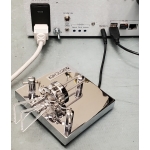Saguaro SR-74 Shortwave Receiver
 Click to enlarge |
|
Explore the fun of shortwave listening, with a display that mimics the old slide-rule dials of yesteryear, but brought up-to-date with modern technology (or use the included CubicSDR software to get a traditional spectrum "waterfall"). No dial cords to string! No vacuum tubes! Saguaro can also be used by DIYers as a teaching/learning platform for experimenting with SDR's, Raspberry Pi's or really, anything you can imagine! The SR-74 is a full-featured shortwave (and higher) radio receiver. Since it uses an SDRPlay RSP1A internally, the RF specs match that of the RSP1A. See https://www.sdrplay.com for details. Other SDRPlay products may also work if the mounting hole pattern and location of the USB connector match that of the RSP1A. You could also control other external SDR's from the Raspberry Pi if desired, but they will not work with the Saguaro software. You would have to use CubicSDR or other software.
The kit houses a Raspberry Pi 4B (use your own or buy a 4GB or 8GB version from us) with a quiet fan, and houses an SDRPlay RSP1A SDR (use yours or buy it here), which covers 1kHz (VLF) to 2GHz (Microwaves). An SMA connector on the back panel can connect to any antenna(s) you want in that frequency range. Includes the latest Debian Linux OS image. Runs CubicSDR for a traditional waterfall and spectrum analyzer display, or our "Shortwave receiver" software. The RSP1A is a 14 bit SDR, and the Saguaro software supports AM, USB, LSB, CW-U, CW-L, FM and NBFM. Built-in software digital filters are 200kHz (FM), 12.5kHz (NBFM), 6kHz (AM), 2.8kHz (SSB) and 800Hz (CW).
Assembly time: approximately 12 hours
The kit consists of:
- High quality two-piece .063" sanded, chromated aluminum chassis, with captive nuts and standoffs, black painted top cover, silkscreened back panel, polycarbonate front panel overlay and screw-on rubber feet.
- Pre-assembled cables and ready to cut/strip/tin wires (in the AC power supply and potentiometer and loudspeaker circuits)
- Controller PC board kit (soldering required through-hole kit) with Atmel Mega 644P microprocessor that reads the tuning encoder, RFG and volume control pots and sends that data via the GPIO port to the Raspberry Pi for processing via our open-source Python program. Also includes CW keyer, with back panel controls for pitch, speed and volume.
- High quality, 8 ohm, 4" permanent magnet loudspeaker
- 1/4" headphone jack on the front panel (which quiets the speaker), with external speaker 1/8" stereo minijack on the back panel
- Built-in transformer-operated AC power supply (100-240VAC, 50/60 Hz), double fused, with safety shield, and 12V DC input. Requires about 2A at 12V
- Matrix Orbital HTT70A-IPS 1024x600 HDMI display with resistive touchscreen (touch feature enabled by addition of two cables, which are optional)
- "Velvet-touch" 128 pulse-per-revolution optical encoder and milled aluminum black anodized tuning knob
- RFG and AFG pots, with high quality plastic knurled knobs with indicator line and metal insert with two set-screws
- On/off toggle switch
- Mounting standoffs for DIYers to add other boards of their own creation
- MicroSD memory card with Raspbian Linux and all necessary software (pre-configured - turn on the radio and Linux will load, then autostart the program. Exit to Linux if you want to run Cubic SDR or other software)
- Solder (10' of Alpha 143090 Telecore Plus, No-Clean, Lead-free, .020 diameter"), more available in "Saguaro Accessories"
- Minijack nut driver and 0.050" and .062" Allen wrenches
- 8" USB-B to USB-A cable to connect the SDR to the Raspberry Pi 4B.
- Optional Raspberry Pi 4B with integral fan. Choose 4GB or 8GB model. (Yes! We have them in stock! Not available separately.)
- Optional RSP1A SDR (Optional because we know many already have one. If you want to use one you already have, no need to order it here).
- Optional Touch control allows you to touch the display to change frequency and select features (this option consists of two cables, one to connect the display's touch output to the back panel, and an external 6" cable to connect to the Pi USB input)
- Optional Secondary HDMI monitor interface. Cable connects RPi4B 2nd HDMI output to rear panel. Monitor and external cable not included.
- Optional Wireless (2.4GHz) USB keyboard and mouse. (Requires 3 AAA batteries, not included)
- Optional 3' power cord. Saguaro uses a standard IEC320 3-pin AC power connector. See "Additional Images" tab for a picture.
Your Review: Note: HTML is not translated!
Rating: Bad Good
Enter the code in the box below:



 Brands
Brands Categories
Categories Shopping Cart
Shopping Cart Bestsellers
Bestsellers
 Featured
Featured







